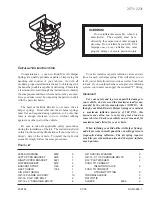
Standard
STD 420-0003
Volvo Group
Version
1
Page
8
6.1.3 Control test with DIDP
At least once a month, a control test shall be carried out in parallel, provided that DIDP is available for purchase
from SP. The test is carried out by pouring 10 g
±
0,1 g of DIDP into the beaker in such a way that the DIDP does
not make contact with the sides of the beaker (above the surface of the fluid).
Place the beaker with the DIDP in the bath, using a different position for each test. After the test period of 180 ± 5
min at the bath temperature of 100 ± 0,5 °C, the fogging value shall be within ± 3 % units of the value stated on the
bottle. If this is not the case, check the test conditions.
The results from the control tests shall be documented and shall be available for reporting in connection with an
audit of the equipment, etc.
At each inspection, the beaker with DIDP shall be moved between the different openings so that it will not be put in
the same place as during the previous control test.
Observe instructions in accordance with the safety sheet for DIDP.
Note: It is very important not to moisten the walls of the beaker with the DIDP when handling the beaker, as this will
lead to a larger area with DIDP and a higher test result
.
6.1.4 Procedure
6.1.4.1 General
The test pieces are placed in beakers with the side that is visible in the car facing up. The sealing ring is placed on
top of the beaker, whereafter the glass plate is placed on the sealing ring.
The beakers with test pieces are placed in the bath that has reached the prescribed temperature.
On top of the glass plate, a filter paper is placed, followed by the cooling plate.
The distance between the bath and the edge of the glass plate shall be 60 mm
±
2 mm. Each time the set
temperature is changed, it is important to check this measure because the fluid volume changes with the
temperature and thus also the distance between the bath and the edge.
The test shall last for 6 h
±
10 min at the prescribed temperature.
At the end of the heat cycle, the glass plates are placed in a rack for 60 min
±
10 min, after which the gloss is
measured.
6.1.4.2 Measuring gloss
The gloss of the glass plates is determined by measuring five points R
01-05
before fogging in accordance with the
glossmeter instructions.
Place the plate in the fixture with the non-tin surface upwards, and focus the measurement on a point in the centre.
The other points to be measured shall be situated 25 mm
±
5 mm from the centre. Measuring shall be done against
a white background. Appropriate is, e.g., a white filter paper. The colour of the filter paper has proved generally
insignificant because the gloss is measured on the surface. However, white filter papers are much more common
than black ones.
The measuring shall be carried out in such a way that it is ensured that the same point is measured before and
after fogging, i.e. R
01
=R
11
After the fogging test, the measuring is repeated in the same way, i.e. R
11-15
. The mean value of these values is
the fogging which is emitted during the test.





























